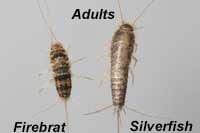
How To Get Rid Of Firebrats
If you have an active firebrat infestation, follow these guidelines to learn how to get rid of firebrats, and the best products for treatment.
Even though Firebrats and Silverfish are similar in appearance, their habitats are a little different. Silverfish prefer damp, moderate temperature places such as basements, laundry rooms, and under sinks. Firebrats, as their name would suggest, survive best in hot, moist areas.
They all prefer a dark, moist environment and require an abundant supply of starchy foods or molds.
Silverfish and Firebrats are considered nuisance pests that can feed on wallpaper pastes, natural textiles, books, and papers. They also feed on mold or fungi that can grow on various surfaces.
Firebrats and Silverfish are fast-moving and can travel throughout buildings. Hiding during the day, Firebrats and Silverfish are nocturnal.
Once these insects find a good source of food, they stay close to it. Silverfish and firebrats diets are high in protein, sugar, or starch, including cereals, moist wheat flour, the starch in book bindings, and paper on glue or paste. They are hardy and can live without food for many months. They contaminate human foods with their droppings and scales.

Identify Firebrats

Silverfish and firebrats are very similar in appearance. They both wingless, having a fish-like appearance, and their flat body, which is tapered at both ends, is covered by overlapping scales.
- Firebrats have a dull-gray appearance.
- Adult firebrats are about one-half inch long.
- They have hair-like appendages that extend from their last segment. They are commonly called "bristletails" for this reason.
Firebrat Inspection
Firebrats prefer temperatures around 100 degrees F and are found in boiler rooms and bakeries, around ovens, hot-water heaters, and pipes if found inside.
- They follow pipelines from the basement to rooms on lower floors, living in bookcases, closet shelves, behind baseboards, and behind window or door frames.
- It is common to find them trapped in bathtubs as they were seeking food or moisture.
- Relative humidity of 70 percent to 80 percent is favorable to firebrats because they do require some moisture.
- Firebrats may habitat all year long.
- Firebrats live outside and are found under rocks, leaf molds, or bark, nests of mammals and birds, or termites and ant nests.
Firebrat Control Measures and Recommendations
Mechanical Means (Non Chemical)
Sources of excessive moisture, such as faulty plumbing or condensation that provide the humidity favored by silverfish and firebrats, should be eliminated.
Dehumidifying reduces the moisture content of the air that these insects find essential.
Some methods for dehumidifying include:
- Mend leaking pipes.
- Ventilate closed rooms and attics.
- Eliminate standing water.
- Use a dehumidifier and air conditioner.
Regularly vacuuming cracks and crevices with a narrow vacuum tip can also be an excellent method to physically remove these insects from their harborages. Remove food sources, stored in tight containers. Seal obvious cracks and crevices to reduce harborage sites. Capture firebrats and monitor their movements at night with Trapper Monitor/Insect Traps
Pest Control Chemical Recommendations
Apply residual insecticide around the perimeter of your home along the foundational wall in a 2-3 foot band.
Inside, spray around baseboards, cracks, and crevices, around windows and doors, plumbing under your sinks.
Spray around steam and water pipes
- Recommended residual insecticides: D-Fense SC, Lambdastar UltraCap 9.7, or Onslaught Insecticide .
- Each of these products is odorless and lasts 2-3 months.




